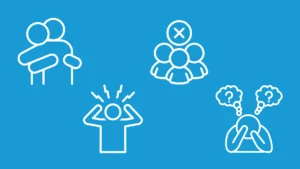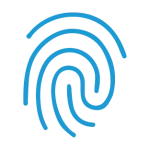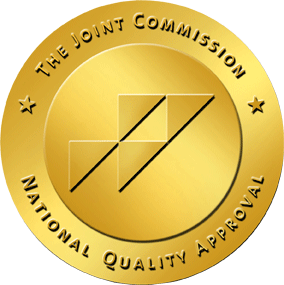Anxiety screening helps identify whether you have an anxiety disorder. If you’ve been feeling anxious, restless, or overwhelmed, this screening can give you a clearer picture of what’s going on with your mental health.
This post tackles what anxiety disorder is, how screening works, and how anxiety can sometimes contribute to addiction and substance use disorder (SUD). By understanding these connections, you’ll be better equipped to take control of your health and well-being.

What Is Anxiety Disorder?
Anxiety is something everyone feels from time to time, like when you’re about to give a speech or take a test. But if you feel nervous, worried, or scared most of the time for no clear reason, you might be dealing with an anxiety disorder.
With an anxiety disorder, your brain stays in “alert mode” even when there’s no real danger. You might feel like something bad is about to happen, even when things seem fine. Your heart might race, your hands may get sweaty, or you may have trouble sleeping, thinking clearly, or even leaving the house.
This kind of anxiety doesn’t go away on its own. It can affect your health, your work, your relationships, and your peace of mind.
Symptoms of Anxiety Disorders
You might have an anxiety disorder if you get these common signs and symptoms:
- Feel tense, jumpy, or on edge
- Worry too much and can’t seem to stop
- Get tired easily or feel weak for no reason
- Have trouble sleeping or staying asleep
- Think something bad is going to happen
- Notice your heart beating fast
- Breathe too quickly or feel like you can’t catch your breath
- Sweat more than usual, even when you’re not hot
- Shake or tremble, especially when nervous
- Have an upset stomach or other digestion issues
- Struggle to focus or think clearly because of worry
- Avoid places or situations that make you anxious
Types of Anxiety Disorders
There are several types of anxiety disorders, and each one affects people differently. Here’s a quick breakdown to help you understand them:
1. Generalized Anxiety Disorder (GAD)
If you often worry about many things, like money, health, family, or work, and those worries don’t go away, you might have GAD. You feel nervous most days, even when there’s no clear reason. About 3% of people in the U.S. live with this kind of anxiety.
2. Agoraphobia
This is the fear of places where you feel trapped or helpless. You might avoid crowds, buses, or even leaving your house because you’re afraid something bad might happen and you won’t be able to escape. Around 1.7% of people in the U.S. deal with agoraphobia.
3. Separation Anxiety Disorder
You may think this only happens to kids, but adults can have it, too. You feel very anxious when someone you’re close to leaves, even if it’s just for a little while. It can cause panic or make you avoid being alone. It affects about 4% of children, 1.6% of teens, and up to 1.9% of adults.
4. Social Anxiety Disorder
If talking to people, going to social events, or even eating in front of others makes you feel scared or embarrassed, you might have social anxiety. It’s more than just shyness—it can stop you from doing everyday things. About 7% of people in the U.S. live with this disorder.
5. Panic Disorder
You may have sudden attacks of fear that come out of nowhere. Your heart races, you feel dizzy, and you might think you’re having a heart attack. These are called panic attacks. If they happen often and you’re scared they’ll come back, it could be a panic disorder.
6. Specific Phobias
This is when you’re extremely afraid of something specific, like heights, spiders, needles, or flying. The fear is strong even if the thing isn’t really dangerous. Up to 12% of people in the U.S. have specific phobias.
7. Selective Mutism
This mostly affects children. It’s when someone can talk normally at home but freezes up and can’t speak in other places like school or around strangers. It’s rare, affecting only about 0.47% to 0.76% of people in the U.S.
Each of these disorders can affect your life, but the good news is they can all be treated. If any of these sound like what you’re going through, you’re not alone—and help is available.
Why Anxiety Often Goes Undiagnosed
Many people don’t realize they have anxiety because they think their feelings are just a “normal” part of life. Maybe you’ve felt you need to “tough it out” or “calm down.” Or maybe you’re used to hiding your feelings from others.
Sometimes, anxiety shows up in ways you wouldn’t expect, such as stomach problems, trouble sleeping, or always feeling tired. That can make it hard for you or even a doctor to spot what’s going on.
And sadly, some people don’t get help because they fear being judged or labeled. That’s why anxiety often goes unnoticed for years.
How Is Anxiety Diagnosed?
Getting diagnosed with anxiety starts with a simple conversation. You talk with a doctor or mental health professional about how you’ve been feeling. They might ask questions like:
- “How often do you feel nervous or on edge?”
- “Do you have trouble sleeping?”
- “Are there certain things you avoid because of fear?”
They may also give you a short questionnaire to fill out. It’s not a test you can pass or fail – it’s just a way to help them understand what you’re going through. To give you an idea, check out Mental Health America’s Anxiety Screening Test.
After that, the doctor or therapist will look at your answers, ask a few more questions, and decide if you have an anxiety disorder. This gives them a better picture of your mental health. If the results show signs of anxiety, they can guide you toward support, like therapy, coping tools, or even medication if needed.
Anxiety and Its Link to Addiction and SUD
If you often feel anxious, you might find yourself turning to alcohol, drugs, or other substances to calm down. This is known as “self-medicating.” While it might seem to help at first, over time, it can lead to an SUD.
How Anxiety and Addiction Are Connected
- Anxiety Can Lead to Substance Use: Research shows that people with anxiety disorders are more likely to develop substance use disorders. A study found that individuals with GAD had higher odds of developing drug dependence.
- Substance Use Can Worsen Anxiety: Using substances might temporarily relieve anxiety, but it often leads to increased anxiety over time. This creates a cycle where anxiety leads to substance use, which then worsens anxiety.
- Mutual Maintenance: Anxiety and substance use disorders can maintain and exacerbate each other. This means that each condition can make the other worse, making recovery more challenging.1
When anxiety and substance use disorders occur together, they can lead to more severe symptoms and complications. Individuals with both conditions may experience greater functional impairment and have a poorer course of illness compared to those with either condition alone.2
What to Do Next
If you’re dealing with both anxiety and addiction, it can feel overwhelming. The good news is that there are steps you can take to break the cycle and start feeling better.
1. Recognize the Link Between Anxiety and Addiction
First, it’s important to understand how anxiety and addiction are connected. Anxiety may lead you to use substances to cope, but using substances can make your anxiety worse. Recognizing this connection is a big step toward recovery.
2. Reach Out for Support
Don’t try to handle this alone. Talking to someone, like a friend, family member, or a mental health professional, can help. They can offer support, listen, and guide you toward the right resources. It’s okay to ask for help.
3. Get an Anxiety Screening
The next step is to get a professional assessment. As mentioned above, screening for anxiety will help you understand what you’re dealing with. It’s the first step toward getting the right treatment, whether that’s therapy, medication, or a combination of both. The earlier you catch anxiety, the easier it is to manage before it leads to bigger problems.
4. Consider Treatment Options for Both Anxiety and Addiction
When you have both anxiety and an SUD, it’s important to treat both at the same time. Integrated treatment programs work best for people in your situation. These programs address the underlying anxiety while helping you manage addiction, breaking the cycle between the two.
5. Take Care of Your Mental Health Every Day
Small steps, like practicing mindfulness, getting enough sleep, and staying active, can help you manage anxiety and reduce the urge to self-medicate. These daily habits can make a big difference over time.
If you’re ready to take the next step in your journey toward healing, OceanRock Health can help. With an anxiety screening, our expert team helps you understand your mental health and guide you toward the best treatment options for both anxiety and addiction. Reach out today.

Sources:
Smith, J. P., & Book, S. W. (2008). Anxiety and Substance Use Disorders: A Review. The Psychiatric Times, 25(10), 19. https://pmc.ncbi.nlm.nih.gov/articles/PMC2904966/
McHugh, R. K. (2015). Treatment of Co-occurring Anxiety Disorders and Substance Use Disorders. Harvard Review of Psychiatry, 23(2), 99–111. https://doi.org/10.1097/hrp.0000000000000058









